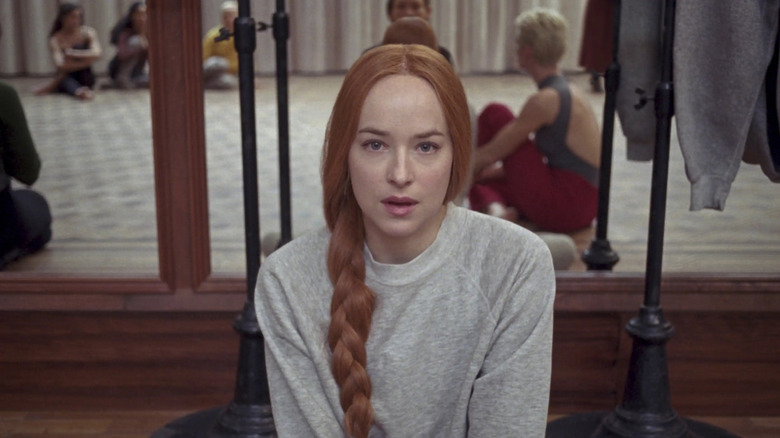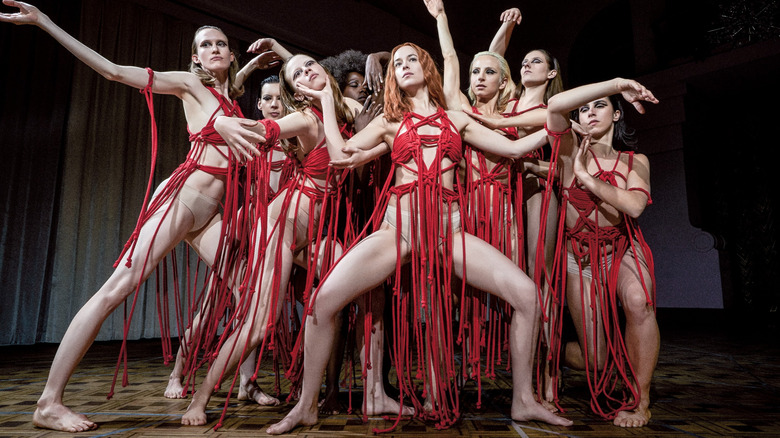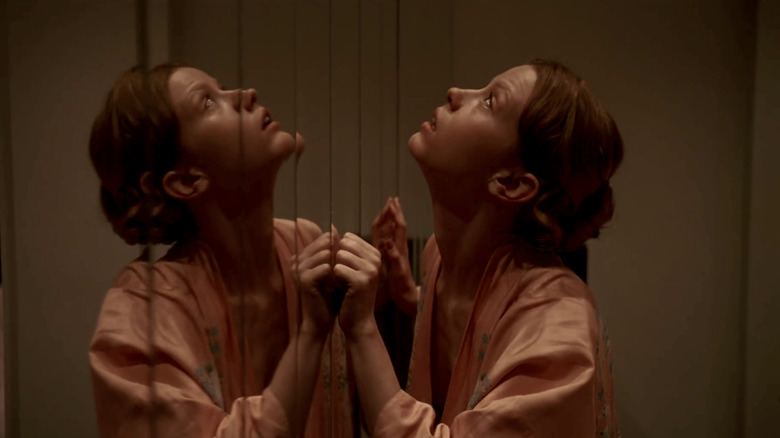The 2018 Remake Of A 1970s Horror Classic Is Somehow Better Than The Original
This article will not be an attack on Dario Argento's 1977 horror classic "Suspiria." Argento's film is, and ever shall be, one of the most exhilaratingly beautiful horror films ever made. The director's bold use of bright colors, elaborate production design, and — most importantly — music (by Italian prog rock band Goblin), turned "Suspiria" from a simple tale of witches and dancers into a nightmarish phantasmagoria of operatic proportions. Few films could ever hope to match the visual excitement, predatory camera movements, and dreamlike imagery of Argento, and several scenes have burned their way into the subconscious minds of horror fans everywhere. The eyeballs hovering just outside a victim's window. The swooping camera, the POV of a demonic bird. The woman who falls into a pool of razor wire. The half-seen silhouette of the witch queen. The breaking stained glass. The knife cutting directly into a human heart. These are all unique and terrifying in the annals of horror.
But, Luca Guadangnino's 2018 remake of "Suspiria" just might be the better film.
The remake, like the original, is also set at a ballet school in 1977 West Berlin. Also like the original, it follows the adventures of the young Susie Bannion (Jessica Harper in the original, Dakota Johnson in the remake) as she uncovers a mysterious coven of witches at the school. In both films, students mysteriously disappear, and Susie uncovers a secret passageway, leading to the lair of an ancient witch, who has somehow been feeding on the energies of the young dancers.
What Guadagnino does that Argento doesn't, however, is add a greater deal of context to the story. Argento is a master stylist, but he's not much of a storyteller. Guadagnino actually bothers to examine what was going on in West Berlin in 1977, answers questions as to why witches would be hanging around in a dance school, and even layers in themes of feminist power and the way it links to the echoes of fascism. Overall, the 2018 film is a more interesting and more complex movie.
Luca Guadagnino's remake of Suspiria is far more complex than the 1977 original
The original "Suspiria" is set in a dance school in West Germany in 1977, but doesn't do much with the location, other than to communicate that it's unfamiliar to a young American dancer and that it's very remote. In Guadagnino's version, the school's front door directly faces the Berlin Wall. This is a time of division and unrest. 1977 was the German Autumn, a period of increased unrest when the Red Army Faction, a far-left protest group also known as the Baader-Meinhof Group (the subject of a 2008 biopic), committed several acts of terror against the strict German government. They hijacked a plane and kidnapped and killed the president of the Confederation of German Employers' Associations, a man named Hans-Martin Schleyer.
The Baader-Meinhof Group is referenced in dialogue. When dancers go missing at the academy, some posit that they ran off and joined the left-wing protestors. Of course, what's actually happening is that the witches hiding out in the academy are somehow assimilating the girls into their demonic enclave, forcing them to be sacrificial victims. The implication is that the witches are using a time of civil unrest to sneak in their acts of black magic and violence. The "terrorists" have a purpose, whereas the witches, on the opposite end, "eat" girls to sustain themselves.
It's also fun that the witches in Guadagnino's film are presented matter-of-factly, naturally, and even kind of plain. They sit around a coffee table in a sweet little German kitchen, kvetching about their jobs, and planning on making sacrifices. Tilda Swinton plays the central witch, but her main concern is being overlooked by the other witches. She's like a timid hopeful waiting for news of a promotion. Their anxiety humanizes and defines the witches in a way Argento's film never bothered to do.
Dancing is important to the Suspiria remake
In Argento's original, the dance school seemed almost like an incidental setting, nothing more than a place to provide Argento with interesting visuals and, uh, leotards. In Guadagnino's remake, dancing became the central method with which witches were witchy. In the film's most memorable scene, the Swinton character pinches Susie's hands and feet, casting some sort of charm on her body. When Susie begins dancing, a woman on the floor below her is terrifyingly and supernaturally puppeted by her movements. The victim's body, unprepared for the dance, contorts, twists, breaks, and cracks. It's a painful, horrid way to die, slain by the terpsichorean muse. Suddenly, it makes sense why witches would be running a ballet academy. The dancing is the best way to evoke demonic power. Dancing becomes pagan, menacing, and terrifying.
In a new twist, Guadangino's "Suspiria" follows a character named Dr. Josef Klemperer (Lutz Ebersdorf, actually Tilda Swinton again), the psychologist of Sara (Mia Goth), a fellow dancer at the Academy. Sara tells Dr. Klemperer that her school is controlled by witches, inspiring him to investigate any malfeasance. Dr. Klemperer uncovers the entire coven's identity but actually finds something more personally relevant: the fate of his wife, who died in the Holocaust. He, too, is a survivor and is wracked by survivor's guilt, feeling he didn't do enough to stem the tide of fascism. This is a symbol of Germany's constant reckoning with its wartime past, and how it directly links to the unrest of 1977. Not to mention, the current unrest seems to be enabling the re-growth of evil right under the noses of German citizens.
Evil, the new "Suspiria" says, is an active choice, and we can fight it, or be sucked into its grotesquerie. We can gain power, but it's useless unless we wield it properly. And that's what the new "Suspiria" is really examining: the uses and misuses of political power. It can be used for good evil, or a mixture of the two, but when misused, it leaves cultural scars.


